#Middle Chalk fossil
Explore tagged Tumblr posts
Photo

British Chalk Fossil Echinoid - Echinocorys scutata tectiformis - Cretaceous, Birling Gap UK
Offered here is a superb example of a British Chalk Fossil Echinoid, specifically Echinocorys scutata tectiformis, from the Middle Chalk Formation of the Cretaceous Period. This particular specimen was found at the iconic fossil locality of Birling Gap, Sussex, UK���a well-known section of the southern chalk cliffs of England.
Taxonomic Classification:
Order: Holasteroida
Superfamily: Echinocorythoidea
Family: Echinocorythidae
Genus & Species: Echinocorys scutata tectiformis
Geological Context:
Period: Cretaceous
Stage: Coniacian to Early Campanian
Formation: Middle Chalk
Depositional Environment: Calm, shallow marine shelf. The chalk was deposited in warm, lime-rich seas during the Late Cretaceous, forming thick beds of pure calcium carbonate with abundant microfossils and echinoids.
Morphological Features:
Sub-pyramidal to tent-shaped test (shell), a distinguishing feature of the tectiformis form
Bilaterally symmetrical with a flattened base and raised apex
Strong development of interambulacral plates with granular tubercles
Marked periproct and peristome regions
Adapted for infaunal life, often partially buried in the chalk mud substrate
Notable & Scientific Significance:
Echinocorys scutata tectiformis is a notable morphotype that reflects ecological adaptations within the Echinocorys lineage.
These echinoids are important for biostratigraphy within the Chalk and are often used to help date layers and interpret depositional conditions.
Locality Details:
Location: Birling Gap, near Eastbourne, Sussex, UK
Stratigraphy: Part of the Seaford Chalk Formation within the White Chalk Subgroup, which is richly fossiliferous and provides excellent preservation of echinoderm fauna.
Presentation & Authenticity:
All of our fossils are 100% Genuine Specimens and come with a Certificate of Authenticity. The listing shows images of the actual fossil you will receive. The scale rule squares / cube = 1cm. Full sizing details can be seen in the accompanying photograph.
This is a hand-selected piece, chosen for its preservation, form, and scientific relevance. Ideal for fossil collectors, chalk enthusiasts, educational displays, or anyone interested in Britain’s geological past.
Bring a piece of the Cretaceous seabed into your collection today!
#British fossil echinoid#Echinocorys scutata tectiformis#chalk fossil urchin#Middle Chalk fossil#Cretaceous echinoid#Birling Gap fossil#fossil echinoid UK#fossil sea urchin chalk#authentic chalk echinoid#UK chalk fossil#fossil from Sussex coast
0 notes
Text
random stuff—headcanon
synopsis. just miscellaneous stuff that remind me of the li's
pairing. no pairing
words. 210
warning. some suggestive descriptors
a/n. lmfao its been a minute, but i promised i'll put up something. i'll come up with more plot-charged fics but i'll start with something simple and then i'll develop further. just be patient <33

minors do not interact. re-read the warnings before reading, as after clicking “keep reading”, i am not responsible for the media you consume.

Xavier
Houseplants, freshly washed blankets, campfires beneath the stars, far from light pollution, exhibitionism, baby powder scents, scented candles, museums of nature and fossils, old bookstores that sell classics, dinosaur books, board games and card games, midday naps, the word epoch.

Rafayel
Seafoam crashing against the rocks, exquisite fresh sushi at a high-end restaurant, a scattered splat of paint, lace lingerie, natural pigments, Spanish/Mediterranean homes, gold accents, hipster lifestyle, legends and myth, used and loved paintbrushes, Italian dramas and movies, the word flamboyance.

Zayne
clean and organized rooms, hand sanitizer, hot chocolate, mints, displays of tarts and chocolate ganache, a warm cottage house in the middle of an icy mountain, submission, white LED light, anatomy sketches and paraphernalia, German cars, dark circles, Arabic and Eastern medicine, the word stoic.

Sylus
cherries on top of hot fudge, dark roses, red leather seats in luxury cars, crows standing by white doves, gothic homes that scream historical, cuffs and blindfold, old record shops that are owned by an elderly couple, ambient music, late-night drives, vampire makeup looks, the word opulence.

Caleb
cloudy skies, freshly made breakfast with heart-shaped pancakes, playground with screeches of children, knee scrapes with intricate design band-aid, voyeurism, graffiti and chalk work, the smell of gasoline, RnB music, the bright colors that appear during dawn, lego collections, the word nostalgia.

ⓒ 2025 all works done by H109zone do not repost, translate, modify, or plagiarize my work.
#—ₕ'ₛ cₐₗₑb 𖹭.ᐟ 🍎#—ₕ'ₛ ₓₐᵥᵢ ✧.*#—ₕ'ₛ ₛyₗᵤₛ 𓅪𓆩ꨄ︎𓆪#—ₕ'ₛ zₐyₙₑ ❄︎♡#—ₕ'ₛ ᵣₐfy ⋆。゚🌊。#love and deepspace#love and deepspace x reader#lads x reader#xavier lads#xavier smut#caleb#caleb l&ds#lnds caleb#lads caleb#love and deepspace caleb#caleb x reader#love and deepspace sylus#love and deepspace zayne#love and deepspace rafayel#love and deepspace smut#love and deepspace x you#love and deespace headcanon#rafayel x reader#lads rafayel#lads zayne#zayne x reader#zayne smut#caleb smut#sylus smut#sylus x reader
69 notes
·
View notes
Text
For your consideration:
The Adults™️ telling you that bullying is wrong and bad, and if you’re getting bullied you just have to go to a teacher and tell them, only for said teacher to say “he’s not bullying you, he’s just being mean. No I will not do anything about it, not even separate your chairs. You’re being sensitive.”
Grownups simultaneously overestimating and underestimating how much you know/understand. They assume a four year old knows what a middle finger means and spank you when you do it by accident but they also assume you don’t understand certain vocabulary words because they’re “too advanced.”
Just the whole power dynamic where grownups could treat you however they wanted to and you had no recourse. You ask them to do their job and they get mad and punish you for it and nobody will do anything because “they’re the adult, you listen to them.”
The complete and total boredom of being stuck at some sort of gathering your parents wanted to attend, that they said we would be leaving soon, but it’s been three hours since they said that and you just now got in the car but as you did their friend walked up and now it’ll be another 45 minutes of you just sitting in the car while they keep talking.
Adults offering you alcohol and then mocking you for not liking it? As if it would be a good thing for a child to enjoy and want more alcohol???
Adults being mean to you and then expecting you to want to talk to them.
Getting grounded but then finding The Thing your mom took away from you as a punishment and being able to play with it anyway.
Your parents disguising things they wanted to do anyway as a reward for your good grades. Like you’re not slick, I know you wanted to go out to dinner regardless of what my report card looked like.
No, I don’t want to play with chalk on the sidewalk, I don’t like the sound it makes or how it feels in my hands, can I please just have some paper and a pencil? A crayon? Just anything else?
Not understanding how age works. Everyone older than like 15 is a fossil in your mind. They think this is funny for some reason but to you it makes perfect sense that someone who has existed for 10x as much time as you would be considered ancient.
Your parents inexplicably having some crappy finger paint project (that you were forced to do and didn’t even have fun with) printed onto a pillowcase that you now have to keep on your bed until you’re 16???
You expressed that you liked something one time and now you will be receiving Christmas presents themed around it for the next 12 years, even though you didn’t like it that much, even though you have a bunch of other interests that you’ve also expressed, and now you’re kinda sick of it.
The much more horrible version of the above where they mistake their interest in something for your interest in something and now you have a bunch of Big Bang Theory shirts you never asked for, all because you watched it with them for a couple hours one time (because they were hogging the only TV in the house).
Adults telling you “you’re ok” when you’re crying. Like no, I’m really not, my knee hurts and I’m scared out of my gourd.
A friend has once again brought it to my attention that it is unusual to have an intact chronological memory of life prior to age 12 and you know what’s weird to ME is that the rest of yall forgot how to sing the clean-up song
16K notes
·
View notes
Text
Folded Forest: Defining the Jurassic Period
by Jane Thaler
What’s in a Name?
Derived from the words for “middle life” in Greek, the Mesozoic Era consisted of three geological periods: the Triassic, Jurassic, and Cretaceous. While many of us might be aware of all three, the term “Jurassic” has seeped into our everyday lives in a way that the Triassic and Cretaceous have not. We can attribute much of this ubiquity to the wildly popular Jurassic Park books by Michael Crichton and their subsequent film adaptations, but have you ever wondered what “Jurassic” actually means and how scientists define the period’s geological boundaries?
Coining “Jurassic”
The “Jura” in Jurassic refers to the Jura Mountains that run along a large portion of the Swiss and French border. Named for the ancient Celtic word for forest, the Jura Mountains are known for their tree-covered peaks and the folded rocks that comprise them (Jones, 2020, p. 94).

Jura Mountains from Wikimedia Commons.
It was here in 1795 that Alexander von Humboldt, a Prussian explorer and naturalist, documented a series of carbonate shelf deposits from the period now known as the Jurassic and dubbed them the “Jura Kalstein.” Alexander Brongniart, a French scientist known for arranging and describing the geologic formations of the Tertiary Period (66.0 to 2.6 million years ago), coined the term “Terrains Jurassiques” to refer to all Jurassic strata in 1829. In 1832, German geologist Leopold von Buch established the three-fold subdivision of epochs based on the folds of limestone in the Jura: the Lias (Early Jurassic), the Dogger (Middle Jurassic), and the Malm (Late Jurassic). This arrangement remains the basic framework for our geological understanding of the Jurassic to this day (Ogg et al., 2012b, p. 732; Encyclopedia Britannica, 2021a).
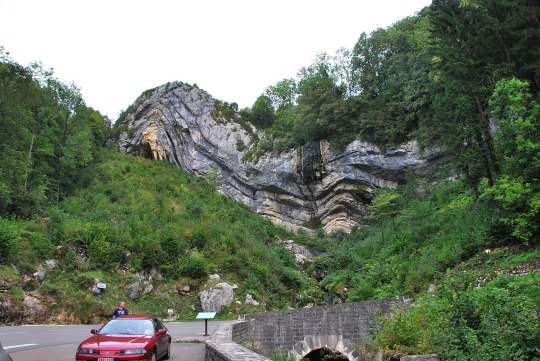
Jura Mountain fold known as the “Chapeau de Gendarme” from Wikimedia Commons.
Beginning of the Jurassic
Nestled between the Triassic and Cretaceous periods, the Jurassic spanned from 201.3 million years ago to 145 million years ago (National Park Service, 2020). The end of the Triassic (so named because it is a group of three strata) and the beginning of the Jurassic is marked by the Triassic–Jurassic (Tr–J) extinction event, sometimes called the end-Triassic extinction. The fourth of five major extinction episodes on Earth (or sixth if you count the current, anthropogenic extinction), the Tr–J extinction wiped out around 75 percent of all marine and terrestrial life (Encyclopedia Britannica, 2021b).
Current evidence suggests that the Tr–J extinction was initially set into motion by movements of the Earth’s crust. As the all-encompassing mega-continent Pangea began to break apart, the associated tectonic shifts caused significant volcanic activity that spewed carbon dioxide into the atmosphere. The resulting global warming disrupted the Earth’s carbon cycle and contributed to ocean acidification (Fuge, 2020).
The ecological niches left open by the Tr–J extinction were quickly filled by remaining species of pterosaurs, crocodilians, turtles, mammals, many species of plants and invertebrates, marine life, and dinosaurs. Though many species died out during the extinction event, the wet and warm climate of the Jurassic in many places encouraged the growth of lush vegetation along with the proliferation and diversification of fauna. Oceans teemed with life, forests flourished, and dinosaurs became the dominant forms of backboned animal life on land during this time (Encyclopedia Britannica, 2021b).

Jurassic landscape in the Dinosaurs in Their Time exhibition at Carnegie Museum of Natural History.
End of the Jurassic
The end of the Jurassic is a bit of a mystery as the geological boundary between it and the Cretaceous Period (the latter name derived from the Latin for “chalk”) remains formally undefined. In fact, the Cretaceous is the only period in the Phanerozoic Eon (541 million years ago to present day) that “does not yet have an accepted global boundary definition” (Ogg et al., 2012a, p. 795). This definitional challenge is due to a number of factors but is mostly attributed to the concept of provincialism or provinciality, which means that plant or animal populations were restricted to a particular area or group of areas (Gale et al., 2020). This resulted in endemic populations, particularly of ammonites, which left uneven or unclear fossil markers in the stratigraphic record (Wimbledon, 2017; see Énay, 2019 for more detail on the J/K boundary debates).
We do know that the end of the Jurassic was marked by the Tithonian–early Barremian cool interval, which began 150 million years ago and continued well into the Early Cretaceous (Ogg et al., 2012a). During this time, some groups of animals did go extinct or become less diverse, like the dinosaurian subgroup Stegosauria that included Stegosaurus, while others increased in abundance, like some ammonite subgroups who survived the Tr–J event. Plants were also developing in important ways during this time. Around 130 million years ago, angiosperms (flowering plants) began to diversify, and they became increasingly dominant throughout the Cretaceous (Friis et al., 2010). Taking the unknowns and variables into account, the end of the Jurassic is currently placed at 145 million years ago.
Naming Geological Periods
Many of the names we still use for geological periods went through a similar process to that of the Jurassic: a scientist named a phenomenon based on the strata they were studying and the nomenclature (the system of names) developed from there. Nowadays, defining and naming geological units is left to the International Commission on Stratigraphy of the International Union of Geological Sciences. The process by which this happens feels about as long as the geologic periods themselves, at least to those of us watching from outside the commission. This is, of course, an exaggeration, but it does take years of work and rounds of voting to arrive at an official stratigraphic boundary designation.
Check out https://stratigraphy.org for the latest updates on humanity’s understanding of geologic time.
Jane Thaler is a Gallery Experience Presenter and Floor Captain in CMNH’s LifeLong Learning Department. Museum staff, volunteers, and interns are encouraged to blog about their unique experiences and knowledge gained from working at the museum.
References:
enay, Raymond (2019). The Jurassic/Cretaceous System Boundary is at an impasse: Why not go back to Oppel’s 1865 original and historic definition of the Tithonian? Cretaceous Research. https://doi.org/10.1016/j.cretres.2019.104241.
Encyclopedia Britannica (2021a). Alexandre Brongniart. https://www.britannica.com/biography/Alexandre-Brongniart
Encyclopedia Britannica (2021b). End-Triassic extinction. https://academic-eb-com.pitt.idm.oclc.org/levels/collegiate/article/end-Triassic-extinction/474417
Fuge, L. (2020). Volcano link to end of Triassic extinction. Cosmos. https://cosmosmagazine.com/history/palaeontology/volcano-link-to-end-of-triassic-extinction/
Friis E. M., Pedersen K. R., Crane P. R. (2010). Diversity in obscurity: fossil flowers and the early history of angiosperms. Philosophical Transactions of the Royal Society B, 365. https://doi.org/10.1098/rstb.2009.0227
Gale, A. S., Mutterlose, J., Batenburg, S., Gradstein, F. M., Agterberg, F. P., Ogg, J. G., Petrizzo, M. R. (2020). The Cretaceous Period. In The Geologic Time Scale 2020 (Gradstein, F. M., Ogg, J. G., Schmitz, M. D., & Ogg, G. M., Eds.). Elsevier. https://doi.org/10.1016/B978-0-12-824360-2.00027-9
Gore, R. (n.d.), The rise of mammals. In National Geographic. https://www.nationalgeographic.com/science/article/rise-mammals
Ogg, J. G., Hinnov, L. A., Huang, C. (2012a). Cretaceous. In The Geologic Time Scale 2012 (Gradstein, F. M., Ogg, J. G., Schmitz, M. D., & Ogg, G. M., Eds.). Elsevier.
Ogg, J. G., Hinnov, L. A., Huang, C. (2012b). Jurassic. In The Geologic Time Scale 2012 (Gradstein, F. M., Ogg, J. G., Schmitz, M. D., & Ogg, G. M., Eds.). Elsevier.
Jones, P. (2020). Jura Mountains, France/Switzerland. In Around the World in 80 Words. University of Chicago Press. https://doi.org/10.7208/9780226682822-026
National Park Service (2020). Geologic time scale. https://www.nps.gov/subjects/geology/time-scale.htm
Pfiffner, O. A. (2006). Thick-skinned and thin-skinned styles of continental contraction. Special Paper of the Geological Society of America, 414.
Sauquet, H., von Balthazar, M., Magallón, S. et al. (2017). The ancestral flower of angiosperms and its early diversification. Nature Communications, 8. https://doi.org/10.1038/ncomms16047
Scotese, C. R., Song, H., Mills, B. J. W., van der Meer, D. G. (2021). Phanerozoic paleotemperatures: the Earth’s changing climate during the last 540 million years. Earth-Science Reviews, 215. https://doi.org/10.1016/j.earscirev.2021.103503
Wimbledon, W. A. P. (2017). Developments with fixing a Tithonian/Berriasian (J/K) boundary. Volumina Jurassica, XV. https://doi.org/10.5604/01.3001.0010.7467
31 notes
·
View notes
Text
Free Wordless Picture Books Activities And Bitmoji Room

E-Therapy has you covered for ELA, Speech & Language, and SEL activities for Reading Month! If you have never used wordless picture books for either virtual or onsite instruction, check out our brand new comprehensive lesson unit with a free bitmoji room about the author, Bill Thomson.
His gorgeous picture books, Fossil, The Typewriter, and Chalk are ideal for teaching and practicing higher level thinking skills, comprehension strategies, learning about point of view, and reading like a writer.
https://youtu.be/315n-1GT7d8
Free Wordless Picture Books Activities And Bitmoji Room
E-Therapy has you covered for ELA, Speech & Language, and SEL activities for Reading Month! If you have never used wordless picture books for either virtual or onsite instruction, check out our brand new comprehensive lesson unit with a free bitmoji room about the author, Bill Thomson.His gorgeous picture books, Fossil, The Typewriter, and Chalk are ideal for teaching and practicing higher level thinking skills, comprehension strategies, learning about point of view, and reading like a writer.
The Bill Thomson Author Study Unit includes free wordless picture books activities made especially for Reading Month! Get your virtual room in Google Slides and a 21-page Bill Thomson Author Study Activity Guide (PDF) which walks you through a multitude of engaing activities to share with students via teletherapy or virtual classrooms.The pages in the activity guide provide ELA, Speech & Language, and SEL activities that connect to each of the 17 links in the Bill Thomson Virtual Room. These lessons are appropriate for second through middle school but may also be appropriate for other age groups depending on how the resources are used.The Bill Thomson Author Study Unit includes links that address multiple instructional goals including the following:ELA and Speech & LanguageDescription skills Oral discussion and turn-taking Verbal and written story re-telling Comprehension strategiesAsking and answering WH-Questions Connections between books and characters Identifying text organization Higher Level thinking skillsMaking inferences and responding to inferential questions Synthesizing and identifying possible themes Point of View Compare and contrast Sequencing Using text to show evidence or back up thinking SELUsing facial expressions and body language to predict or infer character feelings. Discuss how characters respond to stressful, unpredictable, or surprising situations. Using drawing and doodling as grounding activities. Practice active listening. Describing or sharing personal experiences that compare or contrast with characters. Practice empathy by taking the perspective of characters. Creating verbal and written messages of caring Pet therapy and pet discussions Using sounds, music, and visual arts for relaxation and reducing stress. Gratitude journaling Yoga and meditation Get your free resources Click here for your free Bill Thomson Author Study Virtual Room Google Slide Click here for your free Bill Thomson Author Study Activity GuideGet more DIY activities from E-Therapy Subscribe to E-Therapy’s YouTube channel. Hit the bell to be notified when we upload instructional videos for new activities!
Original Source
#online therapy#online speech therapy#online therapy jobs#kids therapy#mental therapy#school therapy#physical therapy#therapy#teletherapy#child therapy#therapy services#teletherapy speech jobs#teletherapy jobs#speech teletherapy jobs#teletherapy speech
2 notes
·
View notes
Note
question: do you think there’s fossils underneath the deepest sea floor? Do you think we could ever get down there to dig them?
Totally there are! In fact, much of the seafloor is made of fossils.
To properly answer this question we first have to talk about hard-rock geology.
Part 1: Hard Rock Cafe
When I say hard rock I mean igneous rocks (rocks that formed by cooling of molten rock) and metamorphic rocks (rocks that formed when already-formed rocks were cooked and altered). This is to set it apart from soft rock (sedimentary rocks—rocks that formed from bits of stuff getting squished together) and prog rock (rock that formed when 1960s musicians took LSD). Hard rock is what forms the basement of the world, beneath all the other layers of rock, and so it’s what we have to start with here.
The ocean crust acts very differently from the continental crust, and that really deserves several long posts of its own. I’ll summarise it by saying this: Ocean crust is thinner, younger, and moves more than continental crust.
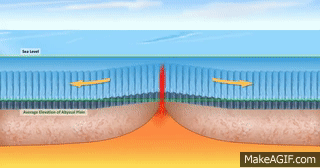
(Image: A gif of seafloor spreading. Oceanic crust moves away from the central plate boundary in both directions, like two conveyor belts going in opposite directions.)
Oceanic crust is formed at the boundaries between tectonic plates, and specifically where the plates are pulling apart from each other (AKA a divergent boundary). This exposes the mantle that is underneath the crust, causing lava to pour out.
Now we come to a very common misconception. It’s very common to think that the mantle is a liquid magma, a molten ocean upon which floats the Earth’s crust. But this isn’t actually true. The Earth’s mantle, despite being at very high temperature, is solid. This is because the enormous weight of the rocks above creates so much pressure that the mantle takes its most compact state—solid. (As a bonus fact, the minerals that make up the Earth’s mantle are lime green.)
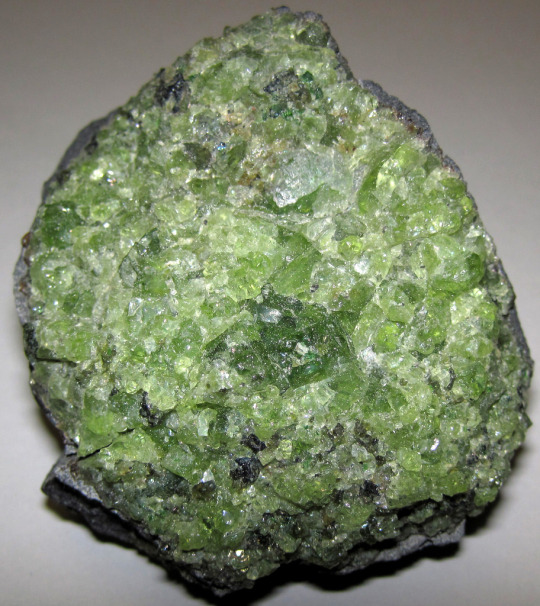
(Image: A chunk of peridotite, the rock that makes up much of the Earth’s mantle. As promised, it is indeed lime green, and is made up primarily of olivine—the same mineral that makes up the gemstone peridot. There’s also some pyroxene in there, the same mineral that makes up asbestos! [Source])
Despite being solid, the mantle is still a fluid. That might take a bit to wrap your head around, so I’ll help you out. Think of silly putty; it’s a solid, but also can flow and deform in a ductile manner. Make that a lot thicker and that’s kind of how the mantle acts.
Back to the divergent boundary. The seafloor pulls apart by tectonic forces, exposing the mantle. Remember, the only thing keeping the mantle solid is the weight of the rock above it that compresses it. So, when that pressure is removed—pow! The mantle melts, and erupts as lava. This lava meets the cold ocean and “freezes” quickly into solid rock, schmamming onto the sides of the plates that are moving apart. And so new crust is born.
If you have taken any middle-school science you probably know that heat makes things expand. And if you haven’t, then you’re now getting a leg up on your classmates. And if you have taken middle-school science but didn’t learn this, I can’t blame you. The school system is a mess and it failing you is not your fault. The fact that you’re reading this is proof it didn’t manage to completely kill your curiosity, so good on you!
Where was I? Oh, yeah. Heat makes things expand. When things expand they became less dense, and so they float a little higher. This means that the brand-spanking-new ocean crust at the mid ocean ridge, which is still hot from being erupted, “floats” on the mantle higher than than the older, cooler crust.
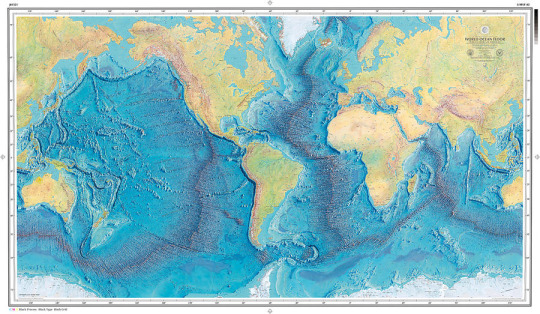
(Image: A map of the world, with particular attention to the topography of the seafloor. It’s not all flat, but rather, has long mountain ranges down the centre of the ocean basins (shown in dark blue). [Source])
This causes the divergent zones in the middle of the ocean to form long ridges where the new crust floats higher than the older crust. Because the crust moves away from the middle ridge like a conveyor belt, the older crust gets pushed further and further away as new crust is created at the ridge.
We can take samples of these crust rocks using super deep rock-coring rigs, and then we can use these cores to conduct radiometric dating and find the age of rocks in different parts of the ocean. This is shown below:
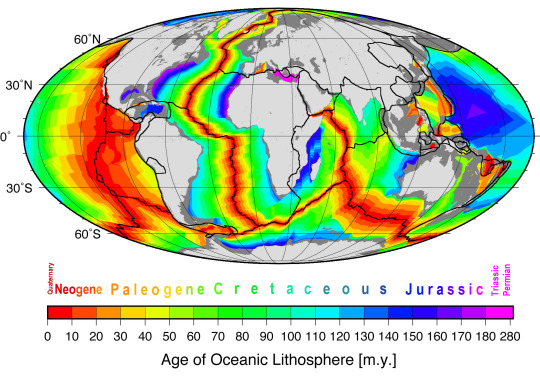
(Image: A map of the world, showing the age of the oceanic crust. The youngest rock is shown in red and it right near the centre ridges of the oceans, while older rock is further away. [Source])
You can imagine “rolling back” the rocks progressively towards the mid-ocean ridge, until South America and Africa fit together right at the ridge—as they did about 100 million years ago.
When crust gets too old, it cools down and becomes more brittle. This can cause it to break and sink under continents, a process known as subduction. This is currently occurring on both sides of the Pacific ocean. The Atlantic, however, has not begun subducting away yet.
Part 2: Soft rock and smooth jazz
All the above was to give a necessary context to talking about fossils in the ocean. We now have a maximum age of fossils that we could possibly find in the ocean; any older than that, and the rocks would be subducted underneath continents and returned to the mantle. The fossils on top of the oceanic crust have to be younger than the crust itself.
So, how are these fossils preserved? This is where we get to sedimentary rocks. I mentioned above that sedimentary rocks form primarily by broken-up bits of other rocks getting schmammed together into a bigger rock. This happens in the ocean, too. Rivers carry sand, silt, and clay into the ocean, and deposit it.
However, these particles can only travel so far. Eventually, these tiny particles of rock will start to sink. The smaller the particle, the easier is is for currents to sweep it up and prevent it from sinking; therefore, the sediment size generally gets smaller the further from shore you get (because bigger particles settle out first).
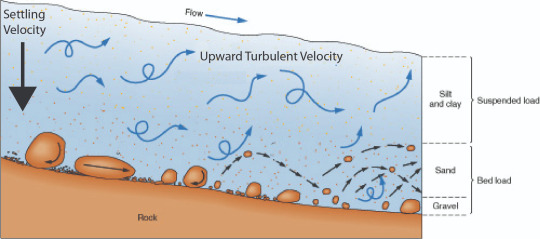
(Image: A digram of sediment transport, showing that larger particles have a greater settling velocity and thus don’t get carried as far away from shore. [Source])
This isn’t the end-all/be-all, by the way. Submarine avalanches called turbidity currents can cause bigger sediment particles to be transported much further, as the underwater landslide can glide on a sheet of water with very little friction, and can thus travel far out onto the flat abyssal plain while moving really fast—like, 60-100km/hr.

(Image: Schematic view of a turbidity current, showing how they form from underwater landslides and travel across the flat ocean floor. [Source])
Both of the above mechanisms can bury the remains of organisms, but there’s an even more significant kind of rock in the deep ocean, and it’s made up of fossils.
See, in the deep, deep ocean, far from shore, it’s hard for sediment to be transported normally. So there’s not a crap-ton in the way of mud or sand. Rather, the sediment is formed largely of the shells of organisms that live above or on the seafloor.
The most common of these are single-celled organisms called foraminifera, or “forams”, which make calcite or aragonite shells. (Calcite is the stuff that makes up chalk, or antacids, or marble, and aragonite is just another form of calcite.) Most foram shells (or “tests”) are near-microscopic, and look like this:
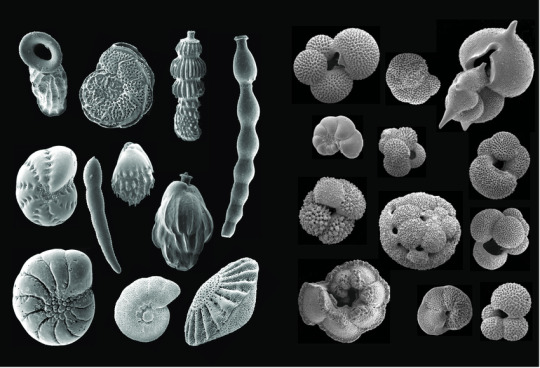
(Image: Scanning electron microscope images of various shells, or “tests”, of foraminifera. Some look like coiled nautilus or snail shells; others are elongate tubes; others look like a bunch of spheres glues together. [Source])
Many of these foraminifera are part of the plankton, and float around by the surface. This is because sunlight makes it much easier to precipitate calcite out of the water. When they die, their skeletons sink to the bottom of the sea and pile up, creating what will eventually become limestone.
Since different parts of the ocean crust are different ages, there is different thickness of sediments in different parts of the ocean. Plankton don’t really care about what’s going on at the ocean floor—it’s 3km below them! So we can think of them as living at all parts of the ocean (though more live at warmer temperatures). Their skeletons sink to the floor of the ocean wherever they are. The oldest crust has been around for a much longer time than the brand-new stuff, so it’s had more time for forams and other sediments to accumulate on top of it. Brand new crust is rough and naked, but old crust is smooth due to being covered by a thick blanket of limestone.
Many other organisms may be preserved in limestone. Some of them, like molluscs, sea urchins, corals, sponges, and trilobites, have shells that are themselves made up of calcite. Others, like vertebrates, are made up of other materials, but can still get buried alongside other organisms with limestone.
Unfortunately, most of the limestones we’ve studied came from shallower seas that covered the continents in bygone ages when the sea level was much higher. Because oceanic crust is eventually returned to the mantle, it doesn’t enter the permanent record very often. Even if it did, there’s still the massive logistical hurdle of digging for something beneath kilometers of water and hundreds of metres of overlying younger sediment.
But that doesn’t stop me from dreaming of someone pulling up a deep-ocean limestone core with a complete plesiosaur skull inside.
#palaentology#paleontology#geology#palaeoblr#geoblr#fossils#plate tectonics#seafloor spreading#long post
267 notes
·
View notes
Text
"Ah. Those two organizations. I've read old international newspaper articles about those two groups some time back. They've really caused quite the ruckus, even moreso on Plasma's end. Like really. They tried not once, but twice. And you'd think getting foiled the first time should be enough for them."
And it'd be no surprise that the Leader of Team Celestial would also have taken notes on such mistakes, and would have made sure that his organization won't get caught on those same mistakes too. The old man was an avid newspaper collector, even in this day and age, so it'd make sense that he'd have international newspapers of old that would catalogue certain events pertaining to these organizations.
Seems that this Volo is a bit of a magnet when it comes to getting wind up in the middle of conflict. Then again, it is as he had said. He's a researcher, so most of the time, said scenarios would be chalked up to 'right place, wrong time', or 'right time, wrong place'. So what he did say made sense.
Well, if push comes to shove that she'd inevitably run into him at the wrong time, then she'd do what she must. Hopefully.

"Alright, very well then." A nod. "The closest ones somewhat within proximity of Cosmos Observatory would be Fae Deepwoods. I'd assume you came here from there, but then again, you probably came from the port from Adamantine Town. Its named such due to the fact that not only it has an abundance of Fairy Types there, the forest also plays tricks on you. Many trainers and ordinary folk tend to get lost there all the time, that the League had to map out the right directions so as nobody would be all turned around in that place."
"I assume that you've already crossed Blackout Cave, too." She added. "Aptly named for its pitch-blackness, from what I have heard, the old mining routes there also managed to unearth some ancient fossils. Though the fact that the place is blindingly dark without any proper light source would mean that there might be specific sections of the cave that was generally left untouched by anyone. Funny thing though? There were some stone tablets that were unearthed there two years ago. They're currently being held in the Argentum Museum of Argentum City."
"Now, if you go past that, and ahead of Adamantine Pass and Adamantine Town, you'd soon find yourself in Qliphoth Ruins. It is said to be the ruins of a supposed ancient civilization that established themselves around a great tree of sorts. However, nowadays what remains are what used to be their civilization. Even the tree itself is now but a husk of what it once where."

"See, here's the thing. Qliphoth Ruins used to be accessible to all. However, for some apparent reason, the path that leads to the husked out tree itself has recently been blocked off. This was done due to the fact that said path has recently become perilous for some reason. And that's not all, the tree itself has now displayed unnatural, anomalous phenomenon, almost similar in nature to the current phenomenon that's plaguing the highly restricted Cryptid Isle for years now. I know you said just the ones accessible near here, but it has to be said too. Cryptid Isle is one of the most restricted places in Spira, that not even nearly all of us Gym Leaders has access to it. Only the Professor, the final Gym Leader, Elite Four and Champion themselves have the authority to do so."
"Anyway back on topic. The path to the tree of Qliphoth Ruins has been closed off due to anomalous events, yes. There's also a round the clock surveillance set in place too, since there has been incidents of smartasses trying to get into the restricted area by air."
"There are other places of interest, but those are already farther from this observatory." Ella stated. Volo did told her to relay out places just near Cosmos Observatory after all. Otherwise, she'd give him quite an earful in regards to enumeration.
Though she'd just add a bit more as a bonus.
"Though Adamantine Pass also can be used as a shortcut you see, as it has an intersection that leads to either Grandmoss City or Adamantine Town. I mention this because Grandmoss City is referred to as the 'Gravesite City', mainly because of its history of where people bring their dead to. Grandmoss Tower is the final resting place for Pokémon, while Grandmoss Gardens is that for humans. Though back during ancient times, people used to deliver their dead, human or Pokémon alike, to Mt. Necros, which is called such due to it being an ancient burial ground."

"Coincidentally, my twin sister, Laura, is the Gym Leader of Grandmoss City. Maybe you'll end up meeting her there, too? If she asks, tell her I sent you or something. She'd understand. Hopefully."
Now that was interesting. Not that Volo was going to go out of his way to get into trouble of course; he didn't really care that much about physical harm to himself (his Pokemon though, he'd rather keep them out of danger as much as possible). But the fact that the Grunts weren't privy to enough information to discern a Team goal and yet they were still willing to, he assumed, die to keep it secret?
It didn't make much sense to him. It felt like he was missing something. But who knew how Teams like that worked? It wasn't like he had that much experience with things of that nature. Maybe the leader was just that charismatic that he didn't need to get them involved with ideologies to get them to follow them.
A cult of personality perhaps?

Volo hummed a bit, smiling once more.
"Hmhm... something like that," he replied lightly. "Team Plasma is a pain in the Unova region, quite a violent bunch, and I've been caught in the middle of a few situations much to my chagrin. And I try to do what I can to avoid Team Rocket's radar; they're a bit too organized and frightening for my tastes." He laughed nervously.
He waved the pen a bit in a twirling motion, mostly to keep his hands busy as he continued.
"But, that's just what happens when you're in my line of work. As I said, I'm a researcher, with a deep, personal interest in history, mythology-slash-folklore and religious studies." He rocked back and forth on his heels a bit, pen back to the paper. "And considering the very nature of this region's tight-knit relationship with local folklore and history, I can only assume it'll be likely that I'll have run-ins with them in some form or another."
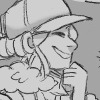
"On that note though! What can you tell me about the local historical points of interest and their significance? Just the ones near this city. And how many are open to the public?"
Not that public access matters much to me. There's always workarounds, be it red tape or greasing palms or other favors. Though I wonder if the tactics I usually use will work here? They certainly take their history quite a bit more seriously than most regions...
It would be a lie if Volo said that he wasn't a bit intrigued by the whole thing; Team Celestial and their mysterious goals, the Starchild that went unseen during the events two years ago, Jirachi's mere existence.
The Champion that saw it all two years ago...
It was all such a curious situation. And if he happen to learn something about Team Celestial along the way, then he would possibly have some leverage for when he met the Champion. Information was, after all, the one commodity that was always in demand.
20 notes
·
View notes
Photo


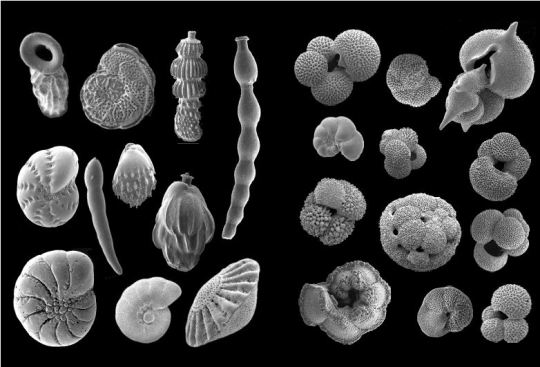
Everyday Mineral #3: Calcite
Calcite is a calcium carbonate mineral. It generally forms by precipitation from warm sea water, but also forms nearly anywhere that there are warm fluids. Several organisms (coccoliths and forams, to name a few) create shells that are made out of calcite. Geologists find calcite incredibly useful because the chemistry of calcite shells can be used to reconstruct the chemistry of the water that the organism lived in. Additionally, bedded rocks made of calcite (called limestone) are generally loaded with fossils, which allows geologists to use the fossils as indicators of the age of the beds.
Calcite has tons of use in normal everyday life. Aside from the obvious ones such as buildings made of limestone (or marble) blocks, calcite powder is a key ingredient in modern concrete. Dyed calcite powder is pressed into molds to make sidewalk chalk! Un-dyed chalk is used to line athletic fields! Do you take vitamins? Look at the ingredients, “calcium carbonate” is probably on the list- calcite is used to hold the vitamin together until your stomach acid (mostly hydrochloric acid) dissolves it and releases the vitamins to be digested. The list goes on and on.
Photos: top: Amazon.com, middle: Wikipedia, bottom: thenaturalhistorian.com
9 notes
·
View notes
Text
So I beat the story of Pokemon Shield yesterday, and now I’ve had time to think about everything. Spoilers below the cut. Also super long post.
First I wanna focus on gameplay.
Overall, fantastic Pokemon game. I liked a lot of the new Pokemon, I felt there was a really good variety of Pokemon available throughout, graphics were good, the gym missions were (mostly) clever and (mostly) fun.
I heard people had complaints about the starters, but I like them. I picked Scorbunny and was terrified he’d end up Fire/Fighting, but Cinderace (and all the starters) remained single-type. I think their designs are cool! I love Rillaboom’s drum and Cinderace’s soccer fireball attack. I like Inteleon the least of the three, but I still think his design is neat. It is basically finger guns: the Pokemon, which is funny, but not particularly interesting to me. I’m glad I picked Scorbunny.
I liked the set up of the Gym Challenge, though the pacing was a bit weird. Not sure if that was me or the game, but I felt like there was very little story between each gym. That led to me doing several gyms in rapid succession, then spending 3 hours in the Wild Area doing nothing, then tackling another set of gyms. But the gym challenges were fun! Except the fire one. I hated that. And the battles themselves felt awesome! The crowd cheering (especially in the final part of the music, oh my god that was so good), the huge Pokemon, the dialogue, it all made for a match that felt like it mattered. Even if I one-shot all their Pokemon, the match still felt meaningful. It wasn’t just stomp and move on.
I think the Wild Area was a cool experiment, but either make the whole game like that, or don’t have it. It feels like the Safari Zone; an area disconnected from the rest of the game, with the express purpose of catching Pokemon and nothing else. Except it’s so huge and seems to have every single Pokemon in the game, so long as the weather is right, that I feel like there was no point in catching Pokemon anywhere else. Why bother even touching the tall grass when I’m travelling through the regular world, when I can just catch whatever would be in there in the Wild Area later? And frankly, I never really got punished for that mentality. I can just catch them all in the Wild Area later. The only hurdle is they all turn level 60 after you become champion, which I have very mixed feelings about. I would like to hear their explanation for doing that, tbh.
Max Raid battles feel really cool, but god damn, Nintendo, you have got to get a better connection system. Half the time, I can’t find any raids to join because there are no shout cards popping up and the button to get new cards isn’t there for some reason. Even when I can see the cards, most of the time I fail to join, either because the raid already started or the person cancelled the raid. There’s only a 3-minute window to join, and with the infrequent appearance of cards (with no timestamps) I have no idea if any of the cards I see are even from the past 10 minutes, let alone past 3. And the NPCs are randomly selected and use their moves randomly, so once you get to the 5+ star raids, you cannot use them at all. One of them is a friggin’ Magikarp that uses Hydro Pump for no damage and misses half the time anyway. Why!? That was funny exactly zero times!
The music, however, I have zero complaints about. Fantastic soundtrack! I love the gym battle music, and the Team Yell fight music, and the Wild Area bagpipes, and the legendaries fight music, and just pretty much all of it. If they release the soundtrack, I’m buying it immediately.
Graphics were good. I wasn’t blown away by them, but it’s a pretty game.
One thing I noticed is how rushed things started to feel towards the end. Initially, the world feels enormous. Routes are long and winding, and it really feels like exploring things. But the further into the game you go, the shorter the routes get. And there’s no Victory Road at all. Just an extremely short route called White Hill, with, like, 6 trainers and a couple grass patches. You take a train to the White Hill Station, and if you look at the map, you see you ended up skipping an entire mountain and a stretch of land twice the length of the actual route. Kinda feels like they planned to do something with all that space, but cut it later on. The forest that they did the 24-hour stream of, Glimwood Tangle? It’s tiny. Like a third the size of Viridan Forest. It’s gorgeous, sure, but I spent more time exploring the first town than I did in that place. The final town certainly looks enormous, but then it turns out you can’t access half of it, and a huge chunk in the middle of the part you can access is taken up by the rail station. Which has nothing important inside it. Just a generic mart and some NPCs to talk to. There was honestly a lot of stuff the seemed like it was gonna be something later, and ended up being nothing. If it’s all content that got cut to release the game sooner, that’s extremely disappointing. Frankly, I wonder if they bit off more than they could chew, turning Pokemon into a console game. They clearly were trying to make it worth being on console, but ended up running out of time.
Now for the story. This is probably the first Pokemon game I feel this way about, but honestly: I loved the characters, but found the story to be pretty lackluster.
Hop has a wonderful character arc, where he’s boastful and energetic, but slowly loses confidence as he keeps losing Pokemon battles, and falls into a depression after a particularly hard defeat. He seems to pull out of it after encouragement from friends, but then he spirals into it again when you beat him in the finals. He spends most of the endgame putting himself down and saying he can’t do anything to help, but as you travel together stopping the Dynamaxed Pokemon, he perks up again (thanks in part of Piers being a really good Dad despite having no kids), and all this culminates in him saying he’s realized being champion isn’t really for him; instead, he’s gonna become a Pokemon professor and travel around helping people and Pokemon wherever he can. It’s really sweet, and I like that we see a rival who actually does get upset that they keep losing to you all the time, without turning them into a villain. Hop is never not your friend during all this; he’s just sad and needs so many hugs.
Marnie was a lot more fun of a character than I was expecting. From the official art, I thought she was gonna be the super reserved, stoic character who gets angrier and angrier as she loses to you over and over. But she’s actually outgoing and fun, and loves battling the player even if she loses. And her brother Piers is just as good at subverting expectations. He’s all dressed up as a super punk rocker who’ll be a terrible influence on everyone, but he’s definitely the Tired Adult of the group when you’re travelling around trying to fix things, and he’s a good Dad friend. Team Yell is much less creepy now that I have context. Piers is a gym leader, and Team Yell is the gym staff that he asked to go help cheer Marnie on during her gym challenge. They’re overzealous, but they’re just trying to help her. Some of them even start cheering for you instead, once Piers acknowledges your skill.
Bede can go fuck himself. I know they tried to give him some kind of backstory or whatever, and some vague punishment/redemption with Opal making him the new Fairy Gym leader, but dude’s a dick, through and through.
I could go on and on about the characters, but this post is already getting too long, so I’ll talk about the story itself now. Through most of the game, you get hints that something bad is happening or going to happen, or something is going wrong, but every time one of those hints pops up, the adult say “Let us handle this, you focus on your gym challenge.” And that kind of bothered me at the time, because it’s like if you get the guard station outside Saffron City and start to argue with the guard, then Lance shows up and says “Hey, why not skip down to Vermillion City? I’ll take care of this.” And that’s the end of it. Next time you try to pass through, it’s open and there’s nothing wrong. You know something is going on, but no one will let you near it, so you just keep going on your gym challenge.
Later you find Leon (the champion) in an argument with Chairman Rose (owner of every corporation in the region) about an energy crisis. Rose says we need to start dealing with it now, Leon says it won’t happen for a thousand years, why do we need to bother right now. Then of course the Chairman triggers the Darkest Day right before your championship match with Leon, ranting about the energy crisis and whatnot, then you have to go stop the super powerful legendary Pokemon he released for Real Reasons That Definitely Make Logical Sense And Don’t Need Explained No Sir. At first, I thought this with a super shitty take on the energy crisis, that we’ll run out of fossil fuels and not have renewable energy ready. But if that’s the case, it’s extremely clumsy, because 1) no owner of a corporation gives two shits about anything a thousand years from now and 2) they had the guy warning everyone about the future crisis also be the guy who almost destroys the whole country. I chalked it up to being rushed and tried not to think about it too hard.
But now I’m thinking differently. There’s something Leon says, after the whole Darkest Day thing is averted: he’s gonna start thinking about the future now, and start working on ways to make the future better (or something to that effect). I think maybe the “moral” of the story is that we shouldn’t just let problems be until they come to a head, and we shouldn’t rely on others to take care of the problems. We relied on the adults to handle things in a reasonable manner, and it nearly led to the apocalypse. So maybe that’s the point? Don’t rely on others to take care of things; if you see a problem, try and fix it. And likely specifically talking about climate change and the destruction of the environment. Galarian Corsola is a bleached, dead coral for a reason.
If that’s the case, then A+ for message, D- for execution. But it’s Pokemon, I know they can’t get too serious about things. But it mostly led to a story I didn’t really enjoy, full of characters that I loved. While I would prefer to finally have the remake of Gen 4, I wouldn’t be sad to see a Sword and Shield 2.
#I really did enjoy the game#and I'm still enjoying it#gonna complete that Pokedex and play through my Sword version#though preferably after I have some way of transferring pokemon between my two versions#fingers crossed for pokebank
1 note
·
View note
Text










Mini PechaKucha Notes
Image 1 - Jurassic Coast - stretches 95 miles from Old Harry Rocks to Orcombe Point and holds 185 million years of history.
Image 2 - The Slow Movement - refers to doing things at the right speed rather than striving to do things faster. This often means slowing down, doing less and prioritising spending the right amount of time on the things that matter to you.
Image 3 - to begin my research I went to explore part of the jurassic coast, this photo was taken on the walk to hurdle door.
Image 4 - Durdle Door - is part of the jurassic coast which is located within the lulworth estate and is a natural limestone arch that was formed when the waves eroded the rock and forged a hole in the middle.
Image 5 - Beach combing - whilst at durdle door, we did some beach combing and fossil hunting. Beach combing is when an individual searches the beach for things or interest or value, in my case, we mostly looked for sea glass and fossils.
Image 6 - Lulworth cove - is another part of the jurassic coast I explored, which is about a 30 minute walk from durdle door.
Image 7 - this is an ammonite fossil that was found in lulworth and is now displayed in a museum section of their visitors centre. Ammonite fossils are one of the most common to find in this area.
Image 8 - As a part of my research, I also looked at Mary Anning who was a pioneering palaeontologist and fossil collector. She was born in Lyme regis which is another area along the jurassic coast. She was the first to find various fossils in the jurassic coast, including the first Plesiosaurus.
Image 9 - these are the things I collected during my trip the durdle door from beach combing. I collected chalk which had broken off of the cliff, as well as a piece of rock that had fallen off the cliff, a small shell and various pieces of sea glass of different sizes and colours.
Image 10 - I began experimenting for my final outcome creating a print of an ammonite fossil through the use of Lino cutting.
0 notes
Text
"Oh a sending stone, so you expected this chat to go well then?" He said as he plucked the stone between metal clawtips. "These aren't exactly easy to make or easy to purchase. Two way communication or one way missive?" He said as he turned it as if trying to see how the light refracted along the gems cuts. "As to what interests me, I'm seeking their shadow manipulation techniques that predate the Scourge conflict of extermination against the Neurbians of Northrend, the arrival of the emissaries of the Black Empire, and lastly the arrival of the Harbinger and the usage of Black Blood." He said as he slipped the stone into a heavy duty container on his utility belt. "Magical refinement always takes divergent paths in times of stress and conflict. You're from Quel'thalas, if nothing else, you know how it goes. One year you can bind necromantic energies only with unwilling hostages and a ceremonial knife, the next, you're doing it with a chicken egg, a little bit of chalk, and the fossilized remains of a trilobite." "I'd like to bootstrap my own methods if they managed to build a better mousetrap." He said with a chuckle and his free hand made the gesture of softly snapping. A jet black card appearing like a street magicians trick between foreclaw and thumb. He offered it to her. Its only marking a stylized fel green eye adorning the middle of it. "My card. If you need me to get ahold of me, just burn it, magical or mundane flame will do the trick." He explained. His own method seemingly a little more humble then their fancy stone. "Though I can't imagine what a woman like you really wants out of Azj-Kahet." He teased, hoping they'd take the chance to plainly explain their own wants as he'd just done.
@eluviannaa
📜 Continued from here.
Eluvianna patiently listened, her measured expression absorbing the glib nature of his words. His pride in his armor was noted, and though she gave no outward sign of being impressed, her mind cataloged the detail for later.
“You certainly paint a charming picture, Lord Felscythe,” she mused. “A consultant, adventurer, hero... collector.”
“And yet, strangely, these platitudes to which I refer are in direct opposition to your portrait as a warlock. Those whose very purpose challenges the unyielding law of pedestrian virtue, that the Light is the only path. It has always seen such deviation, purpose, as that which must be extinguished. To say nothing of merely entertaining it.” She gave him a knowing glance as if to suggest revisiting his words.
“But you seem to imply you embrace the Light’s virtue alongside darkness. Or perhaps yours is no darkness at all, hence my suggestion of this presentation as simply costume. Curious that you should not meet opposition walking such a precarious line, least of all from your kin. Yet, as it stands, I find your dismissal a diversion. Very well. Should you not wish to discuss it further, I will not press. But as one dedicated to nuance, surely you understand that in deflection there is insight.”
“With your work, curated objects, and knowledge... I imagine you’ve had more than your fair share of revelation.”
Her hand lifted to gesture at something unseen. "Artifacts, relics, knowledge hidden in places where shadows gather—those are of particular interest to me." Fingers then folded to rest beneath her chin.
"There are whispers, you see," she continued. "Of places where dark relics trade hands. Places far beyond the Light’s reach, protected by labyrinthine walls and a custom of secrets. And the relics themselves—well, they seem to have a way of choosing their own masters, don't they? Shifting, pulsing with a life that defies understanding, yet they desire to have their stories heard."
“Such interests inevitably draw prying eyes and demand a particular level of discretion. And so you see, my own presentation is in service of such consideration. But presently, I find myself deep within the caverns of Azj-Kahet, following rumors of the ancient and unknowable, long lost to time and obscured to those who walk the surface."
She waved a hand, “And yes, art, even its restoration is a preoccupation of mine. It is inevitably tangled among the many threads that intrigue me. Seeking the…enigmatic.”
She leaned back, her expression more contemplative now. "What you've shared today—your own pursuits, your collections—reminds me of the delicate balance we both walk. It's a rare thing, to find someone who understands the weight of secrets. Perhaps, in time, our paths will continue to converge.”
6 notes
·
View notes
Photo

British Chalk Fossil Echinoid - Echinocorys scutata vulgaris - Cretaceous, Seaford UK
Discover a beautifully preserved British Chalk Fossil Echinoid from the Cretaceous Period, identified as Echinocorys scutata vulgaris. This authentic specimen originates from the Middle Chalk Formation, found in Seaford, Sussex, UK.
This echinoid belongs to the:
Order: Holasteroida
Superfamily: Echinocorythoidea
Family: Echinocorythidae
Geological Age & Formation:
Period: Cretaceous
Stage: Coniacian to Campanian (likely Seaford Chalk Formation age)
Depositional Environment: Shallow marine shelf – calm, warm seas rich in carbonate sediments leading to extensive chalk deposits.
Species Details:
Echinocorys scutata vulgaris is a common chalk echinoid with a thick, ovate test (shell) and highly distinctive symmetrical shape, often likened to a biscuit in form. It was an infaunal detritivore, living partially buried in soft carbonate mud and feeding on organic particles within the sediment.
Morphological Features:
Bilateral symmetry with a slightly domed apex
Distinct ambulacral and interambulacral areas
Well-developed periproct and peristome areas
Test is often robust and shows fine tuberculation (preserved in quality specimens)
Locality: Seaford, East Sussex, England – a classic UK locality for chalk fossils. The Seaford Chalk Formation is part of the White Chalk Subgroup.
Notable Facts:
Often referred to as the "Chalk Heart Urchin"
Found in abundance during the Cretaceous in European chalk seas
Helps in biostratigraphic correlation within the chalk sequences of Europe
Fossil Authenticity and Presentation:
All of our fossils are 100% Genuine Specimens and come with a Certificate of Authenticity. This listing includes photographs of the actual fossil specimen you will receive. The scale in the photo is in 1cm squares (scale cube visible), and full sizing details are included in the images.
This specimen has been carefully selected for its preservation and display quality. A fascinating piece for collectors, educators, or anyone with an interest in palaeontology and British geological heritage.
#British fossil echinoid#Echinocorys scutata#vulgaris chalk urchin#Middle Chalk fossil#Cretaceous echinoid#fossil Seaford Sussex#fossil urchin UK#chalk echinoid specimen#certified fossil echinoid#UK fossil echinoid#fossil sea urchin#authentic fossil echinoid
0 notes
Text
Ichthyornis dispar

By José Carlos Cortés on @quetzalcuetzpalin-art
PLEASE SUPPORT US ON PATREON. EACH and EVERY DONATION helps to keep this blog running! Any amount, even ONE DOLLAR is APPRECIATED! IF YOU ENJOY THIS CONTENT, please CONSIDER DONATING!
Name: Ichthyornis dispar
Name Meaning: Fish Bird
First Described: 1873
Described By: Marsh
Classification: Dinosauria, Theropoda, Neotheropoda, Averostra, Tetanurae, Orionides, Avetheropoda, Coelurosauria, Tyrannoraptora, Maniraptoriformes, Maniraptora, Pennaraptora, Paraves, Eumaniraptora, Averaptora, Avialae, Euavialae, Avebrevicauda, Pygostylia, Ornithothoraces, Euornithes, Ornithuromorpha, Ornithurae
Ichthyornis is one of the most famous not-quite birds, having been named a long time ago and known from fairly decent remains - so well known, in fact, that it, much like dinosaurs such as Archaeopteryx, Megalosaurus, and Iguanodon, is a taxonomic nightmare, and many other similar types of near-birds have had to be separated out from it as their own genera (such as Guildavis and Iaceornis). Still, in its own right, Ichthyornis is an interesting dinosaur, showing much about what the ancestors of modern birds were like. It was a small dinosaur, with a long snout - honestly, a ridiculously large head, when you really look at it - from the the Niobrara Formation of Kansas, the Mooreville Chalk Formation of Alabama, and the Austin Group of Texas. It lived about 93 to 83 million years ago, from the Turonian through the Campanian ages of the Late Cretaceous, making it a fairly common component of the Western Interior Seaway of North America at the time.

By Jack Wood on @thewoodparable
Though named “fish bird”, this was actually due to the vertebrae being considered similar to that of a fish (or considered to be so by Marsh, who described it), rather than due to the potential diet of Ichthyornis itself. Its short tail and toothed snout showed, at the time, an important step in the evolution of birds from their dinosaurian ancestors (though, admittedly, at the time scientists didn’t know their ancestors were dinosaurian). In addition to just having a weird head, it had a wingspan of greater than 60 centimeters, a body length of about 30 centimeters, without the length of the tail. It had a lot of teeth that were in the middle of the jaw behind a little beak at the front of it, and it also had long and robust wings that would have allowed it to soar over the large ocean it called home. Its short, slender legs would not have been used much in locomotion, though it wouldn’t have needed to, given that it probably spent most of its time on the air and floating on the water surface.

By Scott Reid on @drawingwithdinosaurs
Ichthyornis was probably very similar to a gull, diving into the shallow part of the water to catch fish, flying back out to the surface to soar above the sea. It got to be larger than the largest known modern gulls, though it also could be quite small, with a noticeable range of size known for the genus, however, these different sizes don’t seem to delineate separate species, and they probably are just growth stages of I. dispar or other potential species that can’t really be figured out via the fossils. They, thus, grew quite slowly compared to modern birds, which is surprising as they are so close to being modern birds. It lies just outside of the clade of Hesperornis and Neornithes, indicating that, perhaps, the ancestor of modern birds may have been an aquatic sort of dinosaur. This is, of course, under considerable debate, as it seems that the earliest Neornithes may have been terrestrial, as was Apsaravis. So, the jury is still out on that mystery.
Sources:
Martyniuk, M. P. 2012. A Field Guide to Mesozoic Birds and other Winged Dinosaurs. Pan Aves; Vernon, New Jersey.
Mayr, G. 2017. Avian Evolution: The Fossil Record of Birds and its Paleobiological Significance. Topics in Paleobiology, Wiley Blackwell. West Sussex: 88 - 90.
https://en.wikipedia.org/wiki/Ichthyornis
Shout out goes to @likeatreebesidetheriver!
#ichthyornis#ichthyornis dispar#bird#dinosaur#birblr#palaeoblr#likeatreebesidetheriver#paleontology#prehistory#prehistoric life#dinosaurs#biology#a dinosaur a day#a-dinosaur-a-day#dinosaur of the day#dinosaur-of-the-day#science#nature#factfile#Dìneasar#דינוזאור#डायनासोर#ديناصور#ডাইনোসর#risaeðla#ڈایناسور#deinosor#恐龍#恐龙#динозавр
67 notes
·
View notes
Photo
Very long description below the cut.
[image id: a 7 image long comic broken into different size boxes with a running commentary.
First image: five panels, with the commentary, “Something I admire about Terry Pratchett’s books is the way his characters handle resting and fatigue. Tiffany Aching of the Chalk and Sam Vimes of Ankh-Morpork are two very hardworking people.
The first two squares are scenery at night. The left drawing is of the rolling hills of the Chalk with sheep and a potbellied stove being reabsorbed into the turf. On the right is a cityscape of Ankh-Morpork with the Unseen University’s Tower Of Art and the roof of the Library.
Second two panels are of Tiffany Aching and Sam Vimes. Tiffany is a young pale skinned woman with brown hair wearing a blue dress and a large black pointed witch hat and carrying a broom. Behind her are symbols representing things that pop up on her books, like ‘shepherd’s crown’ fossils, a pair of old boots, and a hare, a sheep, fire, snowflakes, the Horse, a wheel of cheese, a witch hat and a silhouette of a soaring bird. Sam Vimes is a middle-aged pale skinned man wearing a brown shirt, brown knee-britches, brown pants and a silvery chest plate and helmet. Behind him are lanterns, smoke, a cigar, lilac flowers, a pair of old boots, a golem and the tail of the Summoning Dark. The last panel has a sheep and a corner of the Library roof.
Second Image: five panels, showing Tiffany doing different things. “Tiffany Aching is a witch. She helps people help each other. She is a midwife, a teacher, a nurse, and the protector of her land.” First panel is a closeup of Tiffany, then she is with a person holding a crying infant, standing in front of two smaller people in a slightly scolding manners, bandaging someone’s leg, and flying over the chalk on her broom at night.
Third Image: five panels, showing Vimes doing different things. “Sam Vimes is Commander of the City Watch. He’s a leader, a father, a night watchman, and a husband.” First panel is a closeup of Sam who looks very tired. Following panels show him running, walking hand in hand with his young son, standing at the end of a dark alleyway and being picked up by his grinning wife, Sybil.
Fourth Image: four panels. “They both pour their energy into their profession, and struggle with the balance of work and rest. And, they both have colleagues who remind them to take care of themselves. Tiffany has the community of witches, along with her parents and her best friends Petulia and Preston. Vimes has the members of the watch, his wife, Sybil and his butler-turned-friend, Willikins.” First two panels are closeups of Vimes’s badge hooked to his breastplate, and of Tiffany’s rabbit necklace. Following panels show both Tiffany and Vimes sitting wearily stooped over on benches, looking very worn out.
Fifth Image: three panels, illustrating a scene from near the end of “Snuff”. Vimes is clearly exhausted and a young watchman [named Feeney] puts his hand on Vimes’ shoulder and walks him to a cabin on the paddle-boat they are on. “He [Vimes] could feel himself swaying. Lack of sleep could poison the mind, drive it in strange directions. ‘I’ll help you along to your cabin, commander. It’s been a very long day.’“
Sixth Image: four panels, illustrating a scene from “I Shall Wear Midnight”. Tiffany, with bags under her eyes, is talking to Preston, who in a young pale blonde man dressed in armor. “ ‘Miss Tiffany, you need a rest, a proper rest, in a proper bed. What kind of witch can look after everybody if she’s not sensible enough to look after herself? Who cares for the people who care for the people? Right now, it looks like it needs to be me.’ She gave in.” The last panel shows a nigh sky with clouds and stars and a crescent moon.
Seventh Image: three panels. “Some of my favorite scenes are when Tiffany and Vimes are comfy in their beds. I’m comforted knowing that even the most hardworking people have moments to themselves. It feels like a reward. They work hard, yes. But then, they rest. They rest so they can do more tomorrow. They rest for the ones they love. They rest for themselves. END.” First panel is Tiffany tucked into bed with her hair down and her eyes closed. Second panel is Vimes, eyes closed, tucked into bed beside his wife Sybil. Last panel shows Tiffany’s witch hat and Vimes’ helmet, as though waiting to be worn the next morning.
/end id]
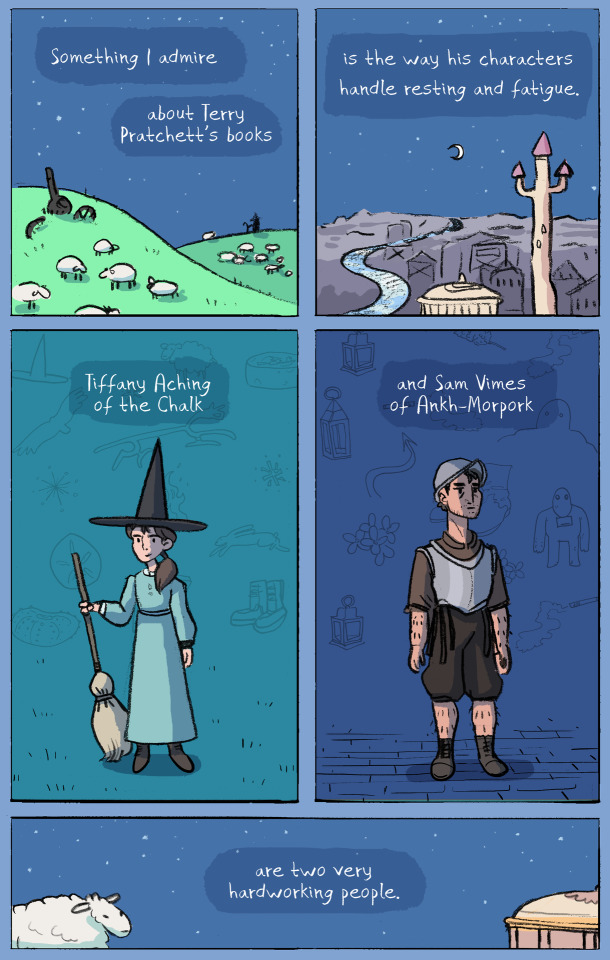
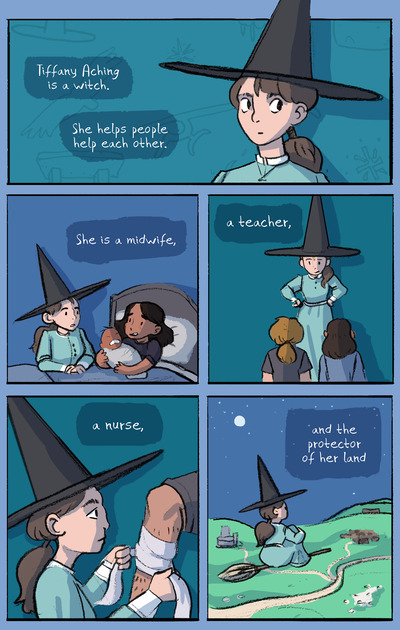
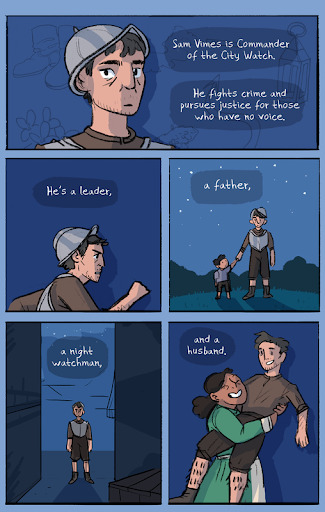
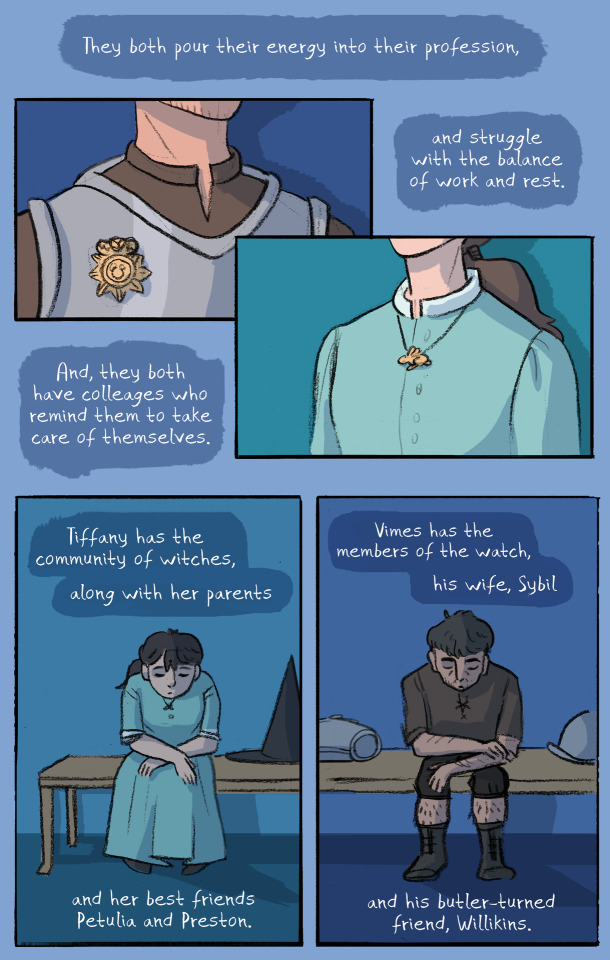
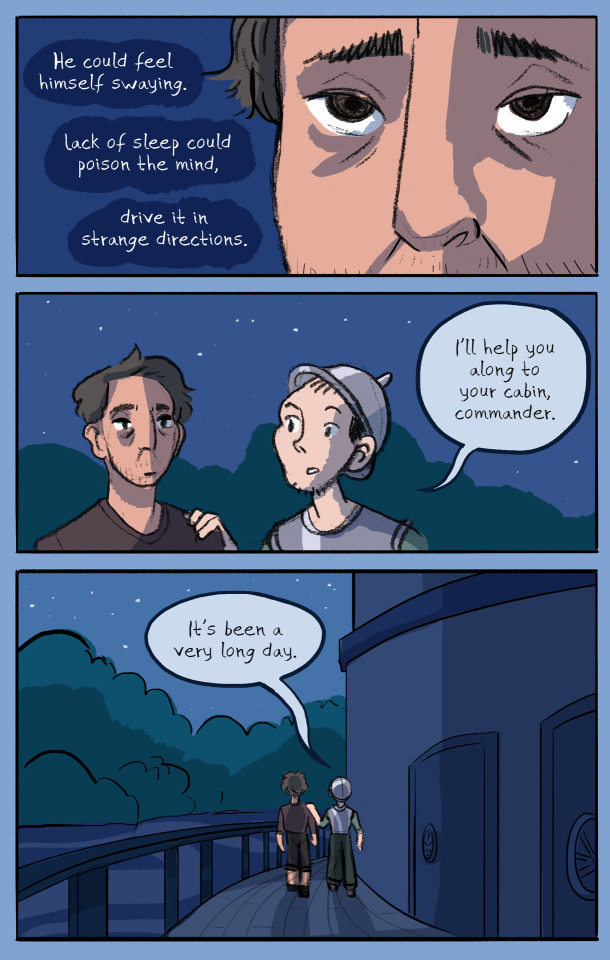

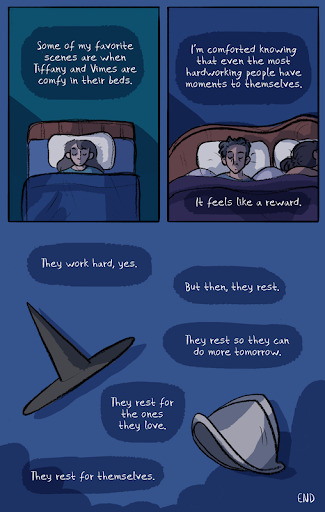
@detective-jasminesa
#discworld#discworld fanart#Tiffany Aching#Sam Vimes#GNU Terry Pratchett#images and words#very long post#readmore#comic
11K notes
·
View notes
Text
White desert
At Western desert Egypt is the best venue ever anybody can have Company Oasis Egypt Safari Tours Package to Bahariya Oasis Desert Egypt and white desert Egypt, desert Egypt
A Western Desert Egypt tourism Safari Egypt is one of the most radiant expertise you will ever have with white desert Egypt and desert Egypt
At Desert Egypt Now you can animate your dream some at days full of delight, at trips White desert Egypt and Western desert Egypt and desert Egypt in a circuit with oasis Egypt safari.
will see the beautiful, with Oasis Egypt Safari in the white desert Egypt and desert Egypt and western Egypt is outstanding for the rock formations and is an area, of considerable loveliness
The White desert best escape anybody can have, Company Oasis Egypt Safari offers a peregrination Package to Bahariya oasis and desert Egypt and the western desert Egypt.
White Desert – charming
The White desert is the best escape anyone can have, Company Oasis Egypt Safari offers Tours Package to Bahariya oasis and Western desert. where you will be able to explore and live Adventure and relaxing.
this trip designed For those who like Adventure to set in the center of Desert Egypt Safari. with us Company Oasis Egypt Safari you will reconnoiter The magic of nature.
exploration of beautiful Egypt and revered for its graceful beauty and history, adventure tour designed by a specialized travel agency Oasis Egypt Safari in trips safari Egypt ( western desert- white desert-desert Egypt-Bahariya oasis ).
For information about the trip to the White Desert Egypt Safari click here
where you will be able to relax in the paradise of Safari desert at night where A sky full of stars and music, enjoyment natural bliss charm. has located 45 km (28 mi) north of the town of Farafra in The Western desert.
A fantastic gleaming landscape in western Egypt, located stretches over 300 sq.km west of the Farafra Oasis between the Nile Delta Valley and the Libyan border.
The White desert Arriving there is like stepping onto a different plan¬et, When you are in the de¬sert, you are entirely discon¬nected from everything that shatters the quiet of your life today, safaris with Oasis Egypt Safari is rightly different.
The safaris to white desert characterized
The desert has a white, cream color and in the shapes of volcanoes, black colored.
a natural museum of chalk rock sculptures.
an inspiring natural sanctuary far from the hubbub.
comprise beau¬tiful forms — dome, minarets, cas¬tles, rabbits, and turtles.
and also the desert has white, massive chalk rock formations that have been created as a result of occasional sandstorms in the area, safaris with Oasis Egypt Safari is rightly stunning because we have a lot of discoveries.
Enjoy adventure tours private in safaris, that privately with Oasis Egypt Safari because of all efforts paid to make your trip successful and enjoyable.
TRIP OVERVIEW
2 Days 1 Night
Day 1
After arriving at The Bahariya oasis start to going to the black desert and going to the Bedouin village we will have our lunch in the cold spring and after that, we going to Crystal mountain it’s This is good appropriateness.
and also going to Al agabat desert then to the white desert to see rabbit rook and going camping. and dinner under of million stars.
Day 2
enjoy trip See the sunrise and take breakfast and going to see chicken and mushroom rook then going to the hot spring, then back to Bahariya oasis and Cairo.
premium safaris, safe has been carefully designed to ensure that not only will you enjoy life-changing experiences but you will do so with the bestead value for your money. now Explore the good and new Life.
The White Desert is part of the Western Desert of Egypt, which makes you feel like you traveled back in time to stone ages again. just let your fiction go, as wild as it can and go to safaris with the Oasis Egypt Safari.
TRIP OVERVIEW
Over Day
from Cairo at 6:00 am arrive at Bahariya oasis at 10:00 am chang the normal car and take the land crouse 4×4. Oasis Egypt safari organizes Safaris The package to the desert includes safari tours, food, drink, and camping accommodation.
(Crystal Mountain Bahariya Oasis Egypt; ) after then start a desert tour by the first stop in crystal mountain after seeing the crystal stone.
and the beautiful aria going to see one of the best places in the national park (al agbat ).first established as a protected area in 2002.
The desert national park the magical place start by mushroom rook information (chicken and camel and rabbit then going back to Bedouin village have lunch in cold spring than going back to stop in the black desert the back to Bahariya oasis
We still pride ourselves on our oasis Egypt safari ensures you all the excitation and the magic of adventure you can handle A during the day. Fill in the following form, and we will contact you as soon as possible.
The best trips start here the oasis Egypt safari Best Egypt Tours. the White Desert is best viewed at sunrise or sunset, in the light of a full moon, which gives the landscape an eerie Arctic appearance.
It’s a very safe and amazing trip and Bahariya Oasis. Completely safe. No hassle from anyone. Lovely people. BOOK THIS TRIP NOW!
Egypt White Desert Camping safaris, Egyptian safari holiday and best the superior oasis Egypt safari looking for a great adventure Deluxe Travel Egypt is offering you Egypt. The safari tour offers a breathtaking landscape, massive sand dunes.
the desert Egypt from Cairo is justifiably the most well-known desert destination in Egypt is an experience never forgotten. As the sky turns pink then deepest fiery orange, the rock-shapes fade, and silence are all around.
The best Egypt vacation to White desert with The oasis Egypt safari
You will camp overnight, and go to Agabat valley, Black Desert, Crystal Mountain, and other sites and stopped wherever you wanted, Absolutely safe.
The distance from Cairo to it is 428 km. The road distance is 536.5 km. to get from Cairo to The White Desert Safari Egypt by taxi, car, and flight. We recommend taking the taxi from Cairo to it which is the fastest option and cheapest.
5 Days 4 Nights Siwa Oasis Tour from Cairo
Pick up services from hotel & return
Accommodation in Siwa 03 star hotel including breakfast & dinner
All sightseeing tours mentioned in the itinerary
All transfers from Cairo to Siwa and Back by an air-conditioned vehicle
And All transfers inside Siwa by 4×4 car
Entrance fees to the mentioned sightseeing
Lunch during sightseeing tours in Siwa (03 times)
English Egyptologist guide during your trip
Mineral water during your trip
Portage when needed
All taxes & service charge
TRIP EXCLUDES
Any optional tours not mentioned in the itinerary
Meals except where indicated
Food, drinks and personal expenses unless specified
Gratuities (recommended)
Day 1: Alamein & Siwa OasisDESCRIPTION
our representative will pick you up from your hotel in Cairo, then drive to Alamein, about 3 hours driving. At Al Alamein, you will gratify to see the site of a great battle during WW II.
as well as visit the WW II Museum and Cemetery it’s bestead, Then drive on to the beautiful bay of Marsa Matrouh on the Mediterranean Coast and continue to Siwa.
Bay of Marsa Matrouh It is about 05 hours driving from Alamein to Siwa, Dinner & Overnight in Siwa, Siwa the maximum remote and unique of Egypt’s Western Desert Oases is Siwa.
Day 2: Siwa Oasis
Breakfast at the hotel, then enjoy the visit to the Old City of Siwa, then continue to Visit The tombs inside Gebel al Mawta ( the Dead Mountain ) where you can see man tombs like SI Amon, MSW Isis, Crocodile Tombs. Then transfer Abu Sherouf, one of the Siwa Villages to enjoy the Bedouin style life and enjoy the Roman Spring eye and handcraft. Live the imaginable Sunset at Alawsut lake. Back to your hotel. Dinner and overnight.
Then transfer Abu Sherouf, one of the Siwa Villages to enjoy the Bedouin style life and enjoy the Roman Spring eye and handcraft. Live the imaginable Sunset at Alawsut lake. Back to your hotel. Dinner and overnight.
Day 3: Siwa Oasis
Temple Of Alexander, Cleopatra Bath
Breakfast at the hotel, visit the Temple of Alexander (the oracle temple) where he is known as the son of the deity of Amun, Cleopatra bath an antique natural spring, and the Temple of Aghormi, dedicated to the God Amon- 26 Dynasty.
Lunch is included. After that transfer to see the Siwa House Museum boasts traditional Siwan objects such as: silver jewelry, music instruments, wedding costumes, baskets, and ceramics. Then another recommended Sunset view at most of the guide books at Fitnas Lake.
Day 4: Siwa Oasis
Abu Ali Village/Tomb of Alexander the Great
Breakfast at hotel, Then start our journey at the Siwa Desert start first with Abu Ali Village where is the Tomb of Alexander the great exists there near to the place, he knew that he is the son of the God Amoun Ra.
Cross the desert to stop near one of the unique archeology signs at Great Siwa Mountain where is the first human footprint above the mountain which dates to the pre-history era.
Continue our Safari tour
Have enjoyment between the dunes till we arrive at the fossils area and see the rocky coral reefs which date to Cambrian era the drive to One of the spring eyes in the middle of the desert ( Shitta Lake) and it is a good chance to watch the Flamenco birds.
Lunch will be served. Then it is a chance to enjoy the sand surfing in the desert before we go swimming at cold spring eye and enjoy the bath and relaxing atmosphere in the Western Desert
this trip designed For those who like Adventure to set in the center of Desert Egypt Safari. with us Company Oasis Egypt Safari you will reconnoiter The magic of nature.
Then it is the time to drive to another spring eyes the hot spring eye for chilling and tranquilizing our Muscles – Ending our day with watching the Sunset at the desert with the Bedouins Tea – Drive back to your hotel – Dinner and overnight at the hotel.
Day 5: Back to Cairo
After breakfast, transfer to your hotel in Cairo and overnight.
Safari trips and offers may interest you:
white desert Egypt tour
Bahariya oasis tour
The white desert Egypt from Cairo
Bahariya oasis hotels
western desert Egypt best of place escape anyone can have is very safe
At Western desert Egypt is the best venue ever anybody can have Company Oasis Egypt Safari Tours Package to Bahariya Oasis Desert Egypt and white desert Egypt, desert Egypt
A Western Desert Egypt tourism Safari Egypt is one of the most radiant expertise you will ever have with white desert Egypt and desert Egypt
At Desert Egypt Now you can animate your dream some at days full of delight, at trips White desert Egypt and Western desert Egypt and desert Egypt in a circuit with oasis Egypt safari.
will see the beautiful, with Oasis Egypt Safari in the white desert Egypt and desert Egypt and western Egypt is outstanding for the rock formations and is an area, of considerable loveliness
The White desert best escape anybody can have, Company Oasis Egypt Safari offers a peregrination Package to Bahariya oasis and desert Egypt and the western desert Egypt.
Tagged
bahariya oasis
desert egypt
safari white desert
western desert
White desert
0 notes
Photo

Science Art on http://guildofscientifictroubadours.com/2020/12/24/song-iron-in-the-sky/
SONG: Iron in the Sky
SONG:
“Iron in the Sky” [Download]
ARTIST: grant.
SOURCE: Based on sss, 19 Nov 2020, “50 years ago, scientists named Earth’s magnetic field as a suspect in extinctions”, as used in the post “Scientists suspect magnetic fields in mass extinctions”.
ABSTRACT: This is a sea shanty, or I guess a space shanty, about prehistoric mass extinctions due to magnetic polar reversals, probably brought on by (or related to) solar flares.
The science here isn’t especially new – the article was mostly a look back at “this day in 1970,” but threw in a more recent study of radiation and magnetic pole reversals, pointing out that maybe those times when north suddenly becomes south (which happens every so often, geologically speaking) leave us more than normally vulnerable to radiation from space. The solar flare business is my own read on the situation, based on my own anxieties about, of course, major coronal mass ejections with the power to bathe our whole planet in lethal radiation for an hour or a week.
I wasn’t really sure I’d do a song about this (it’s not recent research at all), but I did know I wanted to do a sea shanty as soon as I listened to the Fluxpod episode where Matthew and Cates talked about the Tumblr music scene. I’ve been on Tumblr for a long, long time and beyond following OneWeekOneBand for a while, never really thought of it as a musical outlet more than any other blogging platform. But there are hidden worlds, I have learned, including a whole sea shanty subculture.
I like a good sea shanty.
I also like those old British folk songs that Pentangle sang.
I have no idea if this song is based on a memory of one of those songs that I heard long ago, or is just the ur-shanty I carry around in my head. (We all have one of those, don’t we?)
The writing and recording was somewhat straightforward. First, a guitar part based on the melody line in my head, a repetitive structure, a bunch of vocals coming in for the choruses. I knew I wanted to have a crunchy guitar yowling in the background somewhere in the middle. The mellotron bit was a little more random, adapted from a rough draft (a different chord progression using the same structure – thankfully, the mellotron VSTi I was using is tunable). The weirdest thing for me production-wise was realizing that even though I’d recorded to a click track, the drums I was dropping in weren’t lining up.
I was on a different computer than usual. My laptop died, so I was on a slightly less powerful desktop that doesn’t like playing too many MIDI tracks at once, meaning doing a drum track like I usually do is just frustratingly crackly and herky-jerky. Instead, I pasted in drum hits from a John Bonham sample set. And they wouldn’t go right on the grid – I had to keep sliding them around. I’m genuinely not sure, right now, if playing some drums myself would work any better, since evidently I was either sliding the tempo around, or else was falling victim to a wobbly clock inside in the computer. Maybe it’s just because I was singing slower than my usual slow pace. Slow like Low, like the Melvins, like Codeine.
It’s basically a cautionary tale, the song. A warning, like red skies at morning. In harmony, so maybe it’ll stick in the memory long enough to encourage tomorrow’s voyagers to put up extra shielding just in case. It can get harsh out there, when the poles switch around.
Whatever your polarity, wherever you are, have a good Yule.
LYRICS:
The sea can boil like varnish oil The sun’s a burning eye The chalk descends like drowning men Like iron in the sky, my friends Like iron in the sky.
The magnets spin like mortal sin The navigators cry The clouds will spread like molten lead Like iron in the sky, my friends Like iron in the sky.
The mobile phones and radio Components start to fry The screens go dead far overhead Like iron in the sky, my friends Like iron in the sky.
The waves above make waves below The fossils cannot lie We’ll shift our souls from pole to pole Like iron in the sky, my friends Like iron in the sky.
(solo)
Let volcanoes vomit molten rock Let the full moon call the tides Inconstant stars shape what we are Like iron in the sky, my friends Like iron in the sky.
Now no one cares for solar flares And none can name their signs But they’ve come before and will again Like iron in the sky, my friends Like iron in the sky.
var zbPregResult = '0';
0 notes